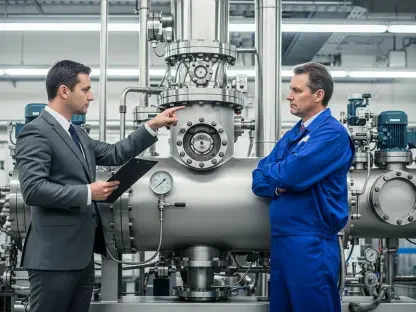Insurance claims reserving is a crucial aspect of the industry where precision and foresight dictate its effectiveness in predicting future liabilities. Actuaries, skilled at utilizing historical data and statistical models, have traditionally played a pivotal role in this process. However, as automation driven by AI and machine learning becomes deeply embedded within insurance practices, the balance between technology and human judgment takes center stage. This dynamic interplay raises critical questions about whether automation can inadvertently overshadow the nuanced understanding that human expertise brings. The discourse revolves around finding equilibrium, ensuring neither the human element nor technological advances are overlooked in achieving a reliable and responsive claims reserving system.
The Evolving Role of Actuaries
Actuaries have long been the backbone of claims reserving, utilizing mathematical models and historical data to manage risk and secure financial stability for insurance companies. By drawing on a range of data points and statistical analyses, they project future outcomes with precision. However, the influx of AI and machine learning into this field is reshaping their roles, presenting opportunities for significant enhancements. These technologies have the potential not to replace actuaries but to augment and refine their capabilities. Through complex algorithms, they streamline processes and improve accuracy, freeing actuaries to focus more on strategic decision-making and risk assessment. This transformation highlights a shift in their fundamental role, allowing a more strategic approach rather than a strictly analytical one.
The integration of technology into actuarial practices marks a move towards improved efficiency in processing and analyzing extensive datasets. Machine learning, in particular, offers sophisticated statistical models that facilitate better predictions, thus ensuring accurate reserving methods. Such advancements enable actuaries to derive deeper insights from data, uncovering patterns that may have been previously overlooked. As these tools become more prevalent, actuaries are empowered to embrace their evolving roles as interpreters and strategists, incorporating innovative methods and sophisticated technologies into their toolkit. This evolution is essential for responding to continuously changing market dynamics and ensuring the industry’s financial health and reliability.
Challenges of Historical Data Reliance
A key obstacle in claims reserving is the reliance on historical data, which may not always offer a reliable foundation for future predictions. While past experiences and trends are valuable, they can be fraught with constraints due to shifting variables such as inflation, changes in claim processes, and demographic shifts. These elements introduce discrepancies, reducing the relevance of historical data to present and future settings. Additionally, external factors such as judicial rulings and economic transformations contribute to a dynamic environment, further impacting the validity and applicability of previous data in forecasting. The inherent unpredictability within these elements accentuates the need for careful consideration and adjustment.
This unpredictable landscape necessitates actuaries to interpret and adjust their approach, allowing for more responsive and adaptive forecasting methods. As insurance portfolios change through mergers or policy adjustments, new risk profiles are introduced, presenting additional complexity. These alterations demand that actuaries incorporate nuanced interpretations that extend beyond data alone, considering broader societal and economic changes. To avoid misestimations that could compromise financial stability, actuaries must remain agile, utilizing insights from both historical data and current dynamics. Embracing this complexity ensures that predictions are accurate, mitigating risks and enhancing the reliability of claims reserving processes.
The Impact of Technological Advancements
AI and machine learning present transformative opportunities within the realm of actuarial science, offering expanded capabilities for analyzing vast datasets. These technologies enhance statistical models, streamline processes, and provide tools for more comprehensive predictions. By automating routine data processing tasks, they allow actuaries to concentrate on strategic analysis, elevating the quality of risk assessment and decision-making. These advancements foster efficiency, enabling insurance companies to adapt to evolving market conditions seamlessly and meet emerging regulatory demands. While automation provides significant benefits, it becomes evident that unchecked reliance on technology carries potential risks that must be adequately managed.
Despite the promise of enhanced accuracy and efficiency, machine learning algorithms sometimes operate within limited parameters, often excluding crucial unquantifiable elements that impact claims outcomes. New regulations, societal shifts, and unexpected events like ‘black swans’ necessitate human judgment to discern subtle nuances and integrate unplanned variations. Balancing automated insights with skilled interpretation allows actuaries to foresee challenges and accommodate unprecedented developments. This synthesis sets the stage for more adaptive reserving practices, ensuring predictions are not only data-driven but also context-driven, thereby embedding real-world relevance into analytical models.
Strategic Interpretation and Decision-Making
A profound understanding of data requires not only the application of advanced algorithms but also human interpretation to capture its broader implications. Human insight remains irreplaceable in piecing together complex narratives, identifying biases, and responding to emerging trends within an insurance landscape. Skilled actuaries are adept at translating raw data into actionable insights, integrating essential elements into cohesive frameworks. This integration fosters robust strategies that align with external factors affecting the claims environment. Through such balanced interpretative approaches, actuaries become key contributors to effective risk management, ensuring informed decision-making grounded in strategic analysis.
Innovation in actuarial practices hinges on the coexistence of automation and human judgment. This dual approach empowers actuaries to extract valuable meanings from data, keeping them responsive to shifts and developments within the insurance industry. By leveraging their understanding of nuanced variables alongside algorithmic efficiencies, actuaries ensure not only the accuracy of predictions but adaptability to evolving circumstances. Setting a precedent in integrated decision-making, professionals are poised to deliver reliable insights, aligning technical advances with narrative understanding for optimal reserving outcomes. Such balanced decision-making frameworks fortify the industry against uncertainties, safeguarding both insurer interests and policyholder security.
Embracing Opportunities and Challenges
Actuarial professionals, exemplified by figures like Agustin Saggese, are presented in this narrative as forward-thinking advocates who champion the integration of technology with traditional actuarial expertise. By embracing both challenges and opportunities, practitioners are encouraged to innovate and refine their methods, adapting to advanced reserving processes that anticipate future developments. This proactive approach positions actuaries as pivotal contributors who harmonize technological tools with expert judgment, fostering dynamic strategies and comprehensive risk management frameworks. The initiative to blend analytic rigor with skilled interpretation signals a shift toward a more responsive, future-proof reserving methodology.
The constant evolution within actuarial practices underscores the profession’s capacity to thrive amid technological change. By acknowledging automation as a supportive tool and openly integrating its benefits, actuaries enhance their ability to navigate complexities of modern insurance landscapes. This transformation elevates their roles from processors to interpreters, enabling them to bring added value and essential insight into securing financial stability. The valuable union of data-driven strategies and human understanding creates a robust interpretative model that meets the demands of contemporary risk environments, ensuring resilient reserving outcomes and strong insurer-positioned protections.
Ensuring Financial Stability
The overarching emphasis on strategic interpretation in actuarial practices highlights the necessity for reliable predictions that uphold the financial stability of insurers and safeguard policyholders. Insurance companies rely on actuaries to deliver forecasts informed by structured frameworks incorporating sensitivity analyses. Such an approach integrates real-world factors into decision-making processes, ensuring precision despite evolving risks and unforeseen shifts. This comprehensive understanding extends beyond data, reflecting preparedness to adapt to unpredictable developments in the insurance sector. Ultimately, this meticulous strategy contributes to maintaining financial equilibrium and securing the interests of stakeholders in an ever-changing environment.
Actuaries must harness their human judgment and technological prowess to extract actionable insights from data. By employing holistic perspectives and considering wide-ranging influences, actuaries offer enhanced clarity to financial stability efforts. Their focus on reliable forecasts enacts a preventative measure against potential misestimation risks, reinforcing both insurer adaptability and policyholder protection. Through enriched frameworks accommodating diverse variables, actuaries cement their responsibilities as key champions of strategic fortitude, ensuring preparedness for potential challenges. This attentive approach serves to secure the future of insurance provision, marrying analytic advances alongside expert interpretation for steadfast resilience.
Human Touch in an Automated World
In an increasingly automated world, the pursuit of balanced claims reserving reaffirms the enduring importance of the human touch. Human judgment fulfills a vital role in bridging gaps left by automated models, providing agile responses to complex dynamics. Skilled professionals are able to identify biases within data, enhancing predictive methods through human insight. The collaborative nature of automation and the human element sustains adaptability, ensuring nuanced understanding in a rapidly changing environment. As technological considerations marginalize certain real-world factors, actuaries remain indispensable in integrating subjective elements into objective frameworks for achieving responsive predictions.
Navigating complexities through skilled interpretation facilitates resilience in insurance reserving. Professionals’ capacity to communicate narratives enriches data-driven analyses, adding insightful layers to understanding multifaceted decision-making circumstances. This assertion underscores the indispensable value that actuaries impart by coupling innovative technology with seasoned interpretation. As claims scenarios evolve, actuaries leverage contextual analysis to create predictive models that adapt in tandem. Through humanized systems, actuaries extend beyond mere data processing, fortifying resilience amid transformative shifts within the insurance industry. Their contributions center on enriching analytic parameters with narrative significance, ensuring an effective convergence of automated efficiencies and human judgment.
Actuaries as Key Protectors
Historically, actuaries have served as the cornerstone of claims reserving, leveraging mathematical models and historical records to navigate risk and protect the financial stability of insurance firms. By employing a mix of data points and statistical analysis, they can forecast future scenarios with remarkable accuracy. However, the adoption of AI and machine learning is transforming their roles, ushering in opportunities for substantial improvement. These technologies aren’t intended to replace actuaries but to enhance and expand their skill sets. Advanced algorithms streamline operations and boost accuracy, granting actuaries the freedom to concentrate more on strategic decisions and risk evaluations. This evolution signifies a shift in their primary focus, moving towards a more strategic approach rather than solely analytical. With improved tools, actuaries can mine deeper insights from data, discover overlooked trends, and embrace their evolving roles as analysts and strategists, crucial for adapting to ever-changing market dynamics.









